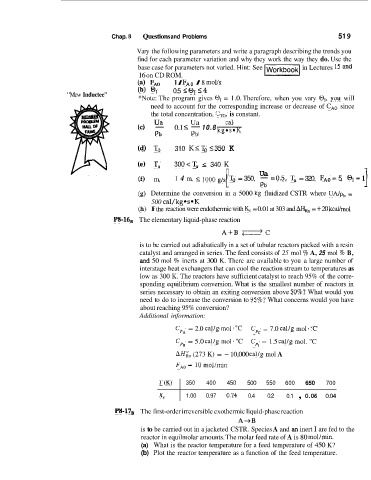Page 549 - Elements of Chemical Reaction Engineering Ebook
P. 549
Chap. 8 Questions and Problems 51 9
Vary the following parameters and write a paragraph describing the trends you
find for each parameter variation and why they work the way they do. Use the
base case for parameters not varied. Hint: See -1 in Lectures 15 and
16 on CD ROM.
(a) FA(> 1 I FAo I 8 mol/s
"Mew Inductee" (b) @I 0.5 501 I4
*Note: The program gives OI = 1.0. Therefore, when you vary O,, you will
need to account for the corresponding increase or decrease of C, since
the total concentration, TTo, is constant.
Ua
Wa
cal
(c) - 0.1 I - 10.8 -
kg*s*K
Pb Pb
(d) T,, 310 KS To 1350 K
(e) T, 300<Ta I 340 K
I Ua I
(f) m, 1 4 m, g 1000 g/s To = 350, -- =0.5, T, = 320, FAO =: 5, 01 = 1
Pb
@) Determine the conversion in a 5000 kg fluidized CSTR where UNp, =
500 cal/kg*s*K
(h) If t!ne reaction were endothermic with K, = 0.01 at 303 and AHh = + 20 kcal/mol
PS-& The elementary liquid-phase reaction
is to be carried out adiabatically in a set of tubular reactors packed with a resin
catalyst and arranged in series. The feed consists of 25 mol % A, 25 mol % B,
and 50 mol % inerts at 300 K. There are available to you a large number of
interstage heat exchangers that can cool the reaction stream to temperatures as
low as 300 K. The reactors have sufficient catalyst to reach 95% of the corre-
sponding equilibrium conversion. What is the smallest number of reactors in
series necessary to obtain an exiting conversion above 50%? What would you
need to do to increase the conversion to 95%? What concerns would you have
about reaching 95% conversion?
Additional information:
CpA = 2.0 cal/g mol. "C Cpc = 7.0 cal/g mol "C
Cpg = 5.0 cal/g mol "C Cp, = 1.5 cal/g mol. "C
AHix (273 K) = - 10,000 cal/g mol A
FA, = 10 mol/min
'T(K) 350 400 450 500 550 600 650 700
1.00 0.97 0.74 0.4 0.2 0.1 , 0.06 0.04
xe
P8-1TB The first-order irreversible exothermic liquid-phase reaction
A+B
is to be carried out in a jacketed CSTR. Species A and an inert I are fed to the
reactor in equilmolar amounts. The molar feed rate of A is 80 mol/min.
(a) What is the reactor temperature for a feed temperature of 450 K?
(b) Plot the reactor temperature as a function of the feed temperature.

